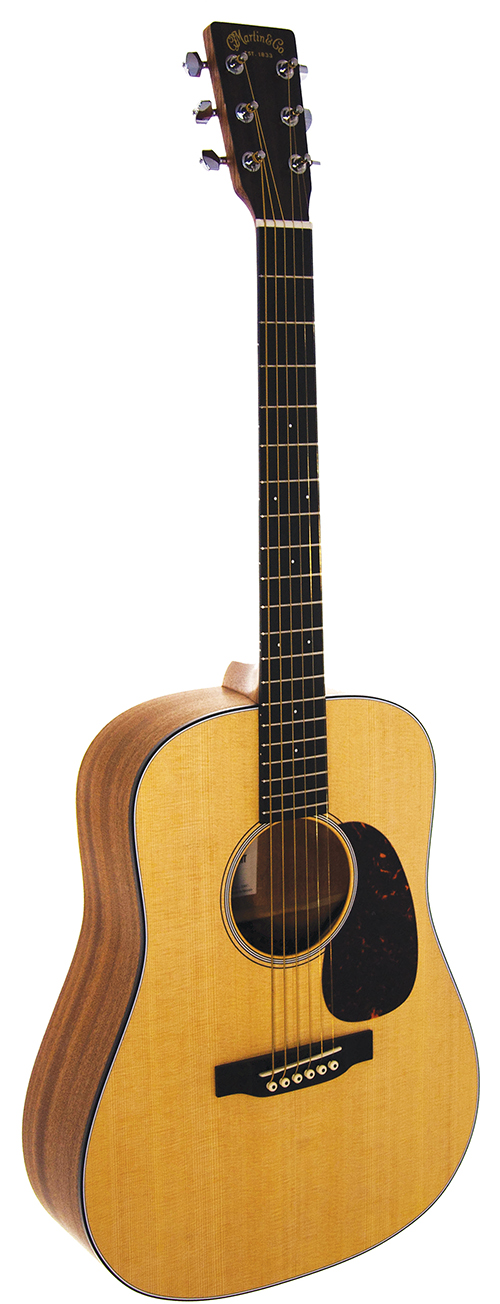Review: Martin Dreadnought Junior
Review: Martin Dreadnought Junior

Smaller guitars have been grabbing themselves quite a lot of attention lately, in the particular case of this slightly under-sized Dreadnought model from Martin, largely due to the huge success of one Ed Sheeran.
When Martin’s excellent guitar clinic presenter Diane Ponzio was in NZ recently she talked about Sheeran taking Martin’s smallest, cheapest compact guitar, the LX1E travel guitar, on tour. His trip around the world turned it into an icon that millions of fans recognised, and as a result half of them seemed to want one.
Try as they might, such demand was never going to be satisfied, so Martin responded with a custom Ed Sheeran model, and also what I would consider a much better solution to the smaller guitar equation. With this model, the Dreadnought Junior, Martin have gone for something bigger than a lot of the diminutive travel guitars, indeed a guitar that you hardly notice has been reduced in size from a full size body. This is 15/16ths in size, or about 30 mm shorter in body length than full size, and with that apparently small change its nicely portable.
For the rrp of $1350 it comes with a well-made Martin nylon soft bag and plenty of other likeable features – the solid hardwood neck, the fat sounding Fishman Sonitone pickup and 14-fret neck.
This gives you something very usable performance- and playing-wise, and it has that rich Martin sound off the solid spruce top. The back and sides are book matched from solid sapele, with Richlite bridge and fingerboard, an alternative to ebony that Martin has developed.
The top has Martin’s famed cross bracing structure, so there is absolutely no compromise with the construction of this guitar. The enclosed chrome tuners take care of business nicely, and the finish is a hand applied oil low sheen finish, for a nice natural wood look.
Making guitars well is something Martin have been doing for many decades. Though many might consider this a lower level guitar, the sound of the Dreadnought Junior is very recordable and usable for a top end recording session. It could as well be the guitar for a younger or smaller person to develop on, and something more established players might keep as a second guitar.
Though it isn’t so much smaller than a full-sized model, you would surely enjoy the added portability when touring or travelling with it. Among issues that are often encountered with small guitars are the neck being too flexible, and consequently going out of tune when played, and also string tension being too high. Neither of these are likely to be a problem on Martin’s Junior, due to the solid wood neck, and the 14-fret neck. Like many other full-size guitars though, it does sound sweet when you tune them down a bit, using Drop D or D open tunings.
Do hit me up for any further questions (facebook.com/malmccallum) if there’s something else you want to know.
You might think volume would be an issue with a smaller guitar, but sound is a funny thing, as we all know. This guitar has plenty of volume. One of the reasons for this is the soft low sheen finish that lets the top speak as they say, and resonate a bit more than a guitar with the full nitro cellulose finish. This has become the norm across quite a few manufacturers, so there must be some logic to it.
Another point Ms Ponzio covered, and a lot of players might have thought about from time to time, is the difference in volume of the full dreadnought shape compared to a more normal cutaway. Martin have done a fair bit of testing and measuring of this, and the result was – not much at all.
If there was anything different with this guitar to say, a full sized D28 Martin for example, then maybe the bottom end is a little light – but not in such a way that you’d feel it was lacking. The Dreadnought Junior is also nicely in tune up the neck, so you’ll be quite happy with open strum chords that have the low drone strings ringing.
